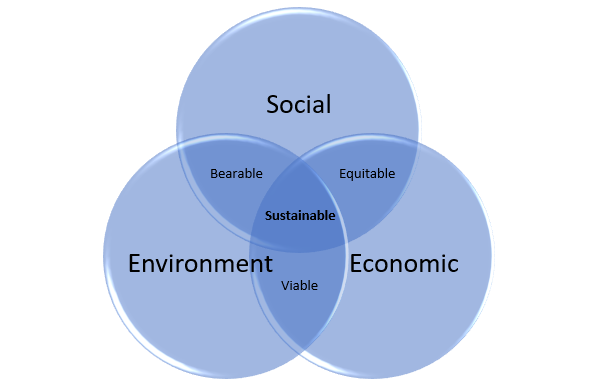Concern over sustainability has never been greater, and many are looking to construction and engineering to ensure structures from here on out are greener and more sustainable than structures of the past.
When it comes to discussing sustainability in construction, the conversation inevitably turns green – that is, environmental factors are often pulled into the foreground. But there are many more sustainable elements that are shaping construction, and in particular, bridge construction.
True sustainability
True sustainability revolves around three “pillars”, each of which contribute towards creating a process that is workable on all fronts. These include social, environment, and economic measures.
A quick look online for sustainable bridge construction shows the heavy-handed environmental approach as posed “solutions” to this conundrum. But while green materials and habitat protection are vitally important in bridge construction, greener moves alone will not achieve true sustainability. The build must consider the environment, but it must also balance or improve the economy it is built within, and balance or improve the social situation of the area it is built in.
Bridge construction will inevitably consume resources through raw material and manpower. This, says Man-Chung Tang, a bridge engineer who writes extensively on sustainability, must be balanced in order to develop sustainable construction processes. Tang illustrates this with a simple equation: Balance = Supply – Demand. So long as the “Balance” remains neutral or positive, sustainability has been achieved. This varies, of course, depending on unique factors city to city, country to country, and bridge to bridge.
Social, environment, and economic pillars
Social
Every bridge project needs to be designed for the society is it serving. Though it seems like a basic concept, in terms of sustainability, taking into account all the factors of the areas the bridge is connecting is a complex task. Once, it may have been enough to simply be of use – now, bridge construction does not only serve the current population, but aims to be built in such a way that it can serve future generations and meet their needs too.
Environmental
This pillar has been spotlighted heavily in recent years, and for good reason. Every industry has been guilty of using more resources than they produce, though the construction sector has been making huge strides in correcting and improving its environmental processes.
But as Tang points out: “The term ‘greening’ represents reducing consumption and encouraging the replacement of conventional fuels with renewable energy. Even though greening may help us to be more environmentally responsible, it cannot solve the fundamental problem of sustainability. As long as the Balance B [in the equation] is negative, we cannot achieve sustainability.”
It is important, therefore, that we do not simply equate environmental practices with true sustainability.
Economical
In terms of a bridge or structure’s economic “pillar”, the outcome of the project must be equal or higher in value than the cost it took to make it. Of course, a structure’s value versus its raw material costs is certainly addressed in the early stages of developments – few companies would agree to build a structure that could not be sold for profit!
Sustainable bridges
In truth, the bridge fabrication sector has already adopted as many sustainable processes as it can in terms of its supply chain, raw materials, and social impacts. Experts suggest that the best way for bridge fabrication and construction to further itself in sustainability is through extending the life span of bridges. As Tang points out in his research paper: “A bridge that lasts 300 years instead of 100 years is equivalent to a reduction in environmental impacts by 66%.”
There are over 50,000 bridges on the UK’s local highway network, and they are covered by a limited maintenance budget of £6 billion for six years (up until 2021).
Bridge maintenance is definitely in the foreground for the future of sustainable bridge construction. No longer will a 50-year life span be considered adequate for a bridge’s duration of service – with improved rehabilitation and repair, bridges will be expected to keep on providing a safe and valuable service socially, environmentally, and economically, for many more years.
But there is one area that Paul Gauvreau, professor of civil engineering at the University of Toronto, suggests has been overlooked by the three-pillar method – particularly when it comes to bridge construction. That hidden, fourth pillar is education.
Gauvreau posits that sustainability in bridge construction must be shaped by improving education for engineers. In doing so, future engineers will be better equipped to come up with new ideas that will push bridge design and construction away from “copies of standard designs”; standard designs of the past which have, perhaps, not been as sustainable as we might have hoped.
“Because these works incorporate no new ideas, they do not create value,” the professor said in his study on sustainable education for bridge engineers. In terms of educating bridge engineers in such a way to help new ideas flourish, Gauvreau says: “The primary benefit that society can reasonably expect from the education of future bridge engineers are bridges that create value through new ideas. These bridges will be capable of performing their practical function for less money than currently available solutions”
By balancing the three pillars of social, environment, and economic value, construction can certainly achieve a new level of sustainability. However, by also acknowledging the fourth, hidden pillar of improved education, bridge construction in particular can benefit from new ideas, new value, and as a result, a new understanding of sustainability.
Sources:
Tang, Man-Chung. (2015). ‘Sustainability – A bridge engineer’s viewpoint’. 18-24. 10.14264/uql.2016.931.
Balogun, Teslim & Tomor, Adrienn & Lamond, Jessica & Gouda, Hazem & Booth, Colin. (2018). ‘Sustainability of Bridge Maintenance. Proceedings of the Institution of Civil Engineers – Bridge Engineering’. 172. 1-27. 10.1680/jbren.15.00027.
Gauvreau, Paul. (2018). ‘Sustainable education for bridge engineers’. 510–519. Vol 5. Issue 6.



 Bitcoin
Bitcoin  Ethereum
Ethereum  Tether
Tether  XRP
XRP  Solana
Solana  USDC
USDC  TRON
TRON  Lido Staked Ether
Lido Staked Ether  Cardano
Cardano  Avalanche
Avalanche  Toncoin
Toncoin